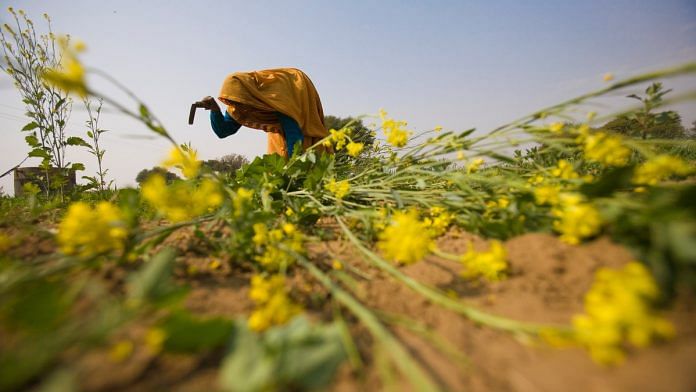When Finance Minister Nirmala Sitharaman gave her Budget speech, there were not many expectations of drastic reforms, especially in the farm sector, in light of the ongoing farmer protests. However, by focusing on fixing the existing infrastructure gaps and by increasing focus on allied activities via more credit and investments, the Budget presents a few good pointers for agriculture.
Also read: India prevailed over Covid. Now Budget 2021 sets the design for economic growth
The good
Focus on infrastructure:
- Allocation under the Rural Infrastructure Development Fund (RIDF) has been increased by Rs 10,000 crore. Indian farmers have long been studied to have suffered due to the absence of infrastructure in their value-chains and this increased expenditure will not only help reduce wastages in the system but also help to increase the share of farmer in a consumer’s rupee.
- Allocation under the Agricultural Infrastructure Fund (AIF) has been strengthened. Approved in July 2020, the fund aims to provide interest subvention on medium-to-long term loans for improving post-harvest management in agriculture.
- To strengthen the infrastructure of the Agricultural Produce Market Committees, or theAPMCs in states, the Budget allows APMCs to avail interest subvention facility under the AIF. This is an important move because it was argued that if due to the agricultural reforms, trading of crops moved out of APMCs, then due to dearth of funds, the mandis would perish overtime. With access to subsidised credit under AIF, APMCs can now borrow to improve their infrastructure.
- To encourage efficient use of water, micro irrigation techniques need to be applied. Increased allocation under the micro irrigation fund is another welcome step.
- Increased focus on lending to the allied activities, mainly dairy and fishery,is a step in the right direction. They are not just the two sectors growing the fastest (at an annual rate of about 6 to 8 per cent), but also form an important part of farmers’ income. Between 2002 and 2015, livestock incomes grew by 17 per cent whereas the income from cultivation grew by 9 per cent.
- Towards bringing greater transparency in reporting of expenditures, the Narendra Modigovernment has acknowledged the huge outstanding dues accumulating for the past few years, mainly in the case of subsidies on food (to Food Corporation of India) and fertiliser (to fertiliser units). Due to this, food subsidy, for example, showed a growth rate of 281 per cent in 2020-21 (from about Rs 1.1 lakh crore in 2019-20 to about Rs 4.2 lakh crore in 2020-21), and to Rs 2.4 lakh crore in 2021-22.
Also read: Economic Survey bats for farm laws, says small & marginal farmers will no longer be ‘enslaved’
The not so good
- The overall budget for the Department of Agriculture, Cooperation and Farmers’ Welfare has been reduced by about 8.5 per cent or about Rs 11,382 crore (difference between the two budgeted values for 2020-21 and 2021-22).
- Allocation under PM’s flagship direct income transfer scheme,PM KISAN, is reduced by Rs 10,000 crore to Rs 65,000 crore. This allocation was about Rs 75,000 crore (Budget Estimate) in 2020-21 and the Revised Estimate for that year is about Rs 65,000 crores. As per the PM Kisan website, there are about 11.52 crore registered scheme beneficiaries and the last installment went to about 9.42 crore beneficiaries. As per Agri Census 2015-16, however, there are about 14.5 crore farmers in the country. So, if there are gaps in the coverage of eligible farmers, then what can possibly explain a reduced budgetary allocation under the scheme, especially given the fact that states like West Bengal (with about 72 lakh beneficiaries) are not part of the scheme yet?
- Allocation has been reduced for both PM-Aasha (Pradhan Mantri Annadata Aay SanraksHan Abhiyan)and MIS-PSS (Market Intervention Scheme-Price Support Scheme) by 20 per cent and 25 per cent, respectively. Both these schemes are important to the oilseed, pulses and copra farmers. By undertaking procurement at MSP, these schemes provide market support to such farmers.
- From Rs 15 lakh crore in 2020-21, the target for agricultural credit has been increased to Rs 16.5 lakh crore for 2021-22. This is great becauseaccess to timely and affordable credit is an important input for a farmer. However, in the Budget, the allocation for interest subsidy for short-term credit has been reduced from Rs 21,175 crore (BE 2020-21) to Rs 19,468 crore (BE 2021-22). As per NABARD, in 2019-20, 60 per cent of the annually disbursed agri-credit goes for crop loans and the remainder are the long-term loans borrowed by stakeholders in agriculture. To make credit affordable for farmers, the government provides two types of subsidies on the interest component of these loans — an interest subvention and a Prompt Repayment Incentive (PRI). This subsidy is accounted for in the Budget. Now the question is about how to read a higher agri-credit disbursement target with a lower interest subsidy allocation?
- Allocation for the “rainfed area development and climate change” is lower in BE 2021-22 than it was in 2018-19. Even allocation for the government’s soil health card scheme (National Project on Soil Health and Fertility) has not seen any increase. In fact, the allocation this year, at Rs 315 crore, is the same as it was in BE 2020-21. This year’s Economic Survey focused on finding ways to bring sustainability in Indian agriculture, so how does one read a lower budgetary allocation to two critical schemes in this regard?
Overall, for the agricultural sector, I feel that the Budget has presented some good guidelines but has clearly missed some critical points.
The author is a Senior fellow (visiting) at ICRIER. Views are personal.






